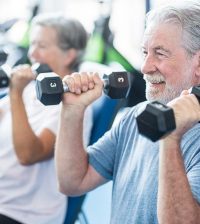- HHS Launches New Autism Study Despite Experts’ Concerns
- CDC Urges Extra Measles Shot For Some U.S. Travelers Amid Outbreak
- Showerhead Water Limits Rescinded as Trump Targets Household Appliances
- Most Women Aren’t Clear When Menopause Might Start
- New Visual Test For Autism Could Aid Earlier Diagnosis
- Half-Million Children Could Die If U.S. AIDS Relief Is Dropped
- Seasonal Allergies Likely To Grow Worse Under Climate Change
- First Baby Born From Robot-Controlled IVF
- Eviction Bans Linked To Drop In Child Abuse Reports
- Bausch + Lomb Issues Recall of enVista Lenses Used in Cataract Surgery
Fitter in 1820: Today’s Americans Spend Much Less Time Being Active

Modern Americans get much less physical activity than their forebearers did 200 years ago, and increasing reliance on technology is a major reason why.
That’s the finding from researchers who used data on falling body temperature and changing metabolic rates in the United States to measure declining levels of physical activity since the Industrial Revolution.
Since 1820, Americans’ resting metabolic rate (the total number of calories burned when the body is completely at rest) has dropped about 6%. That translates to about 27 minutes less moderate to vigorous physical activity a day.
The findings were published Oct. 25 in the journal Current Biology.
“Instead of walking to work, we take cars or trains; instead of manual labor in factories, we use machines,” said lead author Andrew Yegian, a postdoctoral fellow in human and evolutionary biology at Harvard University in Cambridge, Mass. “We’ve made technology to do our physical activity for us.”
He said researchers hope that the findings prompt people to think more about the long-term changes of activity that have accompanied new lifestyles and technology.
The fact that technological and social changes have reduced overall levels of physical activity is well-documented, but how much had not been calculated.
“This is a first pass estimate of taking physiological data and trying to quantify declines in activity,” Yegian said. “The next step would be to try to apply this as a tool to other populations.”
Yegian works in the lab of evolutionary biologist Daniel Lieberman.
“Physical activity is a major determinant of health,” Lieberman said in a Harvard news release. “Understanding how much less active Americans have become over the last few generations can help us assess just how much increases in the incidence of chronic conditions like type 2 diabetes, heart disease and Alzheimer’s can be attributed to decreases in physical activity.”
This study was prompted by a Stanford University last year that found Americans’ average body temperature has fallen to about 97.5 degrees Fahrenheit instead of the well-established 98.6.
Yegian and colleagues figured that lower body temperature and declining physical activity could be linked by metabolism, which produces body heat and is partly driven by physical activity.
More information
The U.S. National Heart, Lung, and Blood Institute offers a guide to physical activity.
SOURCE: Harvard University, news release, Oct. 26, 2021
Source: HealthDay
Copyright © 2025 HealthDay. All rights reserved.










